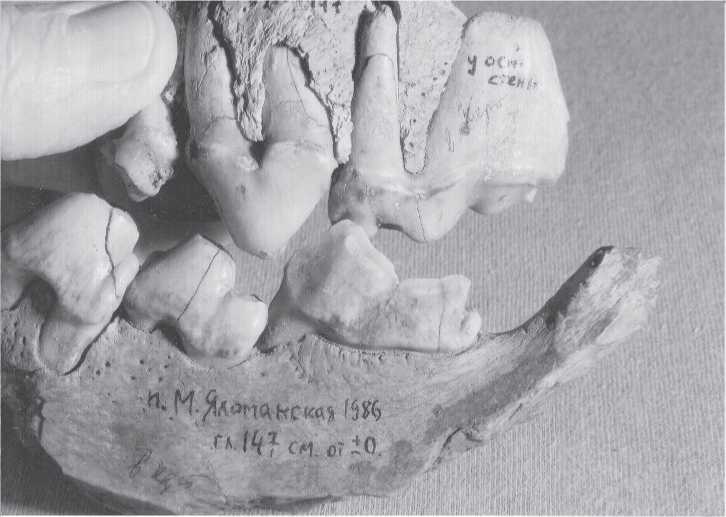Maly Yaloman Cave (Little Yaloman, a nearby river) is located in the northern slopes of the Terektinsky Ridge, Ongudai region, Gorny Altai. According to Kuzmin and Orlova(1998:7) it is at 49°80' N, 86°30' E. The south-southwest-facing cave is 27 m above the level of the Maly Yaloman River, which runs below the cliff that contains Maly Yaloman Cave. The cave mouth is 5 m wide, and at its highest 2.6 m tall. Its length is about 35 m, trending upward so that the endis 11 mabovethe floor level at the entrance. There is ca. 60-70 m2 ofusable floor area, with the entrance platform having some 15 m2 of living space. It is a cave site that had both human and hyena occupants in late Pleistocene times (Fig. 3.84) (Table A1.1, site 16). Vasili’ev etal. (2002:523) list one carbon-14 date of 33 350 BP, derived from charcoal found in Layer 3. There is an additional date of24 130 (SO AN-2404) based on the bone of a yak or bison.
In 1983, hydrologist A. M. Maloletko (Alexeeva and Maloletko 1984) made the first test excavation, a pit about 1.5 m2 near the entrance. His osteological findings included a human tooth (subsequently lost; personal communication from E. V. Alexeeva to N. D. Ovodov), hare, brown bear, cave hyena, red wolf, ass, small horse, bison, Siberian mountain goat, and sheep (Alexeeva and Maloletko 1984). In 1986, Maloletko, Ovodov, and assistants dug deeper in the original test pit in order to better understand the stratigraphy, get charcoal for dating purposes, and to add to the faunal collection. At that time they fully mapped the cave. identified three hearths of differing ages, and found a few artifacts. From this work they identified 28 species of mammal and 16 species of bird, the latter identified by N. Martynovich. In 1988 Valery T. Petrin, leader of the IAE North Asiatic archaeological expedition, expanded the Maly Yaloman excavation to some 45 m2 (Derevianko and Petrin 1988, Derevianko et al. 1998h).
Combining the 1986 and 1988 collections, there are: hare (Lepus timidus), five pieces; cape hare (Lepus capensis), 38; marmot (Marmota baibacina), 21; gray wolf (Canis lupus), 59; fox (Vulpus vulpus), 138; red wolf (Cuon alpinus), three; manul (Felis manul), one; lynx (Felix lynx), one; snow leopard (ounce) (Uncia uncia), eight; cave hyena (Crocuta spelaea), 33; horse (Equus cf. caballus), 50; rhinoceros (Coelodonta antiquitatis), 15; red deer (Cervus elaphus), one; roe deer (Capreolus capreolus), three; goat, ibex, markhor (Capra sibirica), 520; wild sheep (Ovis ammon), one; and wild yak (Poephagus baikalensis), 46. These species, as well as the small mammals and birds, give Maly Yaloman a pronounced steppe quality (Ovodov et al. 2003).

Fig. 3.84 Maly Yaloman hyena. There is much more evidence of this cave having been used by carnivores than by humans in the Pleistocene. These young adult jaws, found in 1986, Layer 3-5 (147 cm), have chewing damage believed to have been due to cannibalism. Upper jaw is 7.5 cm in length (CGT neg. IAE 8-5-03:34).




 World History
World History









